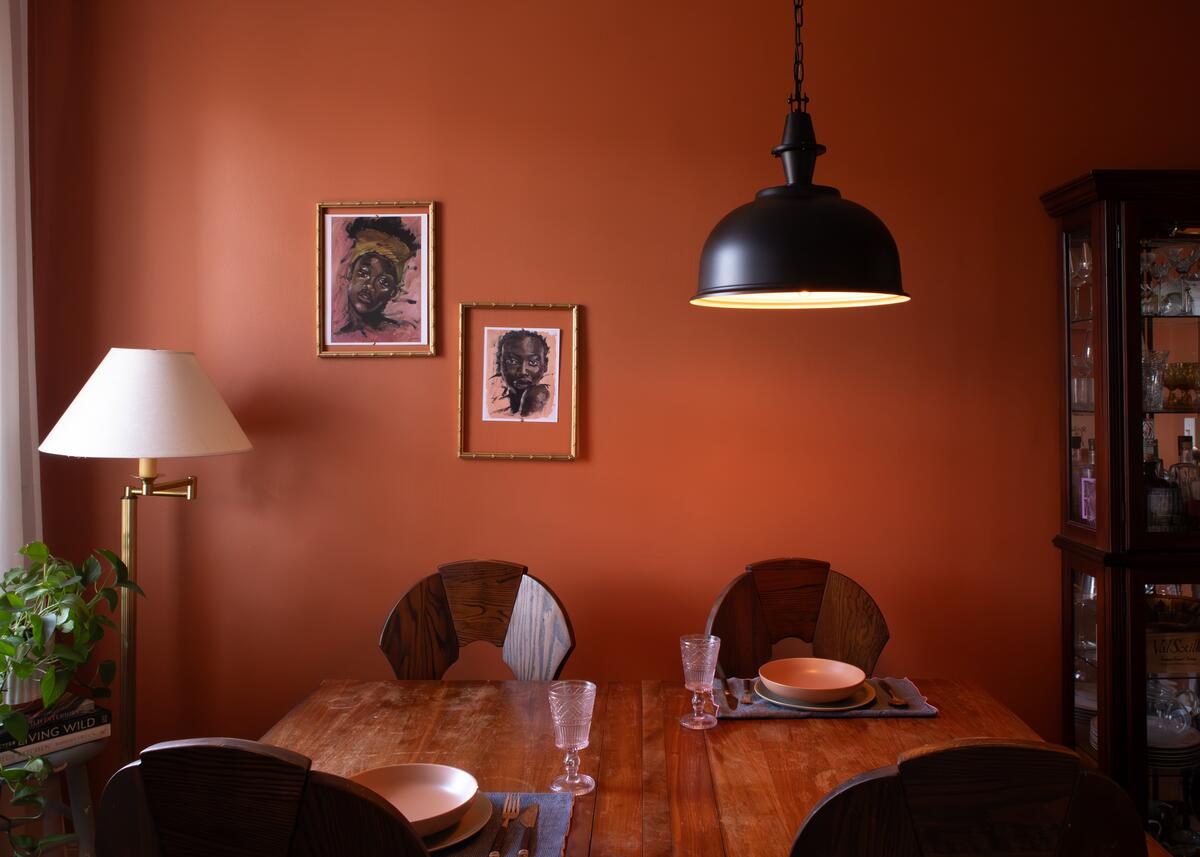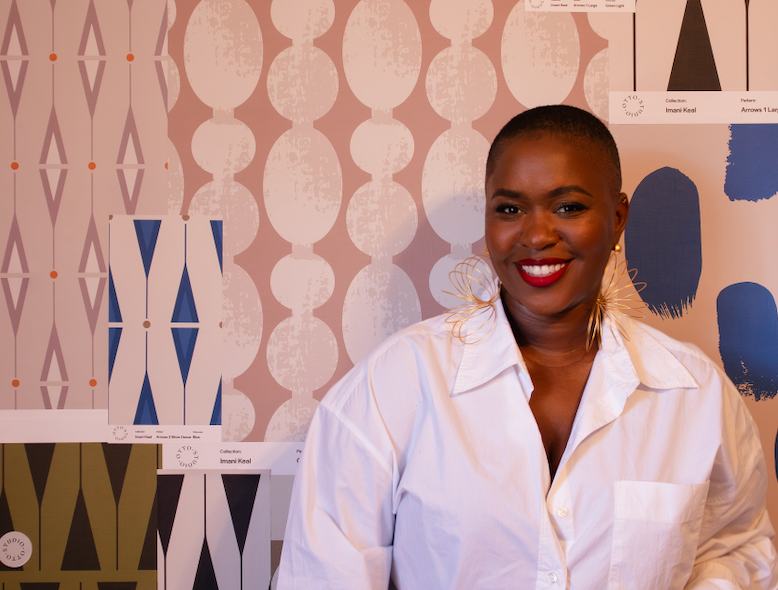In Ask an Influencer, Business of Home explores the creator economy. This week, we spoke with content creator Imani Keal.
Growing up, Imani Keal made it her mission to transform her childhood bedroom. Usually, paint was her first line of attack—hot pink one year, an orange accent wall the next. HGTV’s Trading Spaces was a fount of inspiration, as were the model homes her family toured for fun. And when it came to sourcing, she learned from the best.
“I come from a family of shoppers—as I like to say, my people shop,” says Keal. “My aunt, in her 70s, would wake us up at 8 a.m., like, ‘We’re hitting the stores, and we’re going tristate, so we’re starting in Jersey, then we’re hitting Philly, and we’re going to finish in Delaware.’ That’s the vibe of my family.”
Keal stuck to the creative route in college, studying public relations and ceramics at Howard University in Washington, D.C., before settling down with a job in VIP guest services at the Line hotel in 2017. A few years later, she got a new gig at Waterworks, but when the pandemic hit, her hours were cut—leaving her with much more free time.
“I went from never being home to always being home,” she says. On the rare occasions when she wasn’t home, she was making twice-daily pilgrimages to the only open retail space near her: Ace Hardware. It was a return to form for Keal, who started by repainting her rental apartment, and then took on larger redesign projects within her space. In the meantime, her friends encouraged her to make a dedicated Instagram account for her design content, which she decided to dub Imani at Home.
After a few of Keal’s early videos went viral, her follower count quickly climbed into the tens of thousands. Two years ago she went all in on social media, and today has grown her community to a following of 108,000 on Instagram and 88,000 on TikTok.
Ahead, the creative shares why she offers her e-design services pro bono on social media, how talking about the cost of high-end furnishings fires up engagement, and why she’s unafraid of leaning into the less-pretty side of home design.
An Untraditional Way of Monetizing Design Online
When Keal started gaining an online audience, she began to explore the idea of offering design services—after all, she could only move apartments and redesign her spaces so many times before she ran out of content. But as a creator who specializes in renter-friendly upgrades, she found that her pool of potential clients didn’t quite align with the world of full-service design. “People would come to me, and I’m like, ‘All right, what’s your budget? What do you want to do?’ They’re like, ‘I’ve got $5,000 for 900 square feet,’” she says. “That’s, like, two quality pieces of furniture. It doesn’t feel fair to me to take that amount of money from people [for design services at that level].”

In short, the math simply didn’t work. Still, Keal wanted to find a way to design for [those at an accessible budget tier], and found the solution in the launch of a YouTube series called Fully Furnished. “Basically, people can submit their space to me via the link in my bio, and then I’ll create a video talking through all of the things that I would do in their space,” she says. “I can give the information for free, but make money through YouTube AdSense.”
For now, the series is solely based on creating design plans that viewers can then execute at their own pace and according to their budget. If her platform continues to grow, she aims to keep that ethos going, creating design plans or even executing makeovers for her followers (ideally with the help of a brand partner) at no charge to them. For Keal, it’s a way of reciprocating the support she receives from her followers—and an approach in which she can foster community and spark creativity without feeling like she’s shilling.
“In the era of the creator, the only reason I am able to do this is because of my audience, and I don’t always want to sell people on stuff,” she says. “There’s so much money to be made in other avenues that [full-service design] doesn’t really make sense for me to do. … It would mean hiring a staff, which would mean more overhead, and I feel like it would take some of the joy and the laissez-faire out of running Imani at Home.”
Big-Ticket Items Lead to Big Engagement
One surefire way to attract the internet’s ire? Tell them how much you’re spending on high-end furnishings. Keal recently featured the Easton gooseneck faucet from Waterworks in an Instagram Reel, and immediately received backlash from viewers who suggested that she could afford to buy a home if she could afford a high-end design item like the faucet (which, for the record, she plans to take with her if she moves).
“Videos where I focus on some kind of big price—either a big-ticket item or the cost of my rent—always [get a big reaction],” says the content creator. “I definitely think there’s a lack of understanding about how things are made and the cost that can be associated with making high-quality products in a way where everyone in that supply chain is paid fairly.”
In Keal’s eyes, the controversy exposes a content gap for design audiences on social media. “So much of the interior design space is geared toward people who are [spending], like, $200,000 for just the kitchen, and then another $60,000 for soft furnishings,” she says. “Don’t get me wrong—when I see someone speccing a Carrara marble tub, it warms my heart. But often I see people who were interior designers first [before becoming creators], working with a certain level of client, and they come on the internet to give advice about home and then people read that advice as gospel. While the advice may be good, it doesn’t [always] apply to you.”
That’s why Keal’s videos also include an education component, in which she explains the quality and craftsmanship that goes into high-end home fixtures and decor. The effect, she hopes, is that viewers understand they can invest in quality pieces even if they’re not yet at the point of outfitting their home top-to-bottom with new luxury furnishings.
Focus on Getting Real Instead of Wide Appeal
On social media, there’s an approach to producing design content that caters to every viewer (or at least, greatly reduces the risk of friction) with perfectly styled photos, aesthetically neutral interiors and carefully cut videos that make the entire process appear seamless. Then, there’s the real side of home and design: It’s messy, complicated and ugly at times. Moreover, the end result of any interesting and unique design is subjective, so it’s not realistic to try to appeal to everyone. Instead of caving to the urge to sanitize her content, Keal leans into the controversial side of design, and avoids letting criticism shape her next move.

“My bedroom makeover [performed] really, really well. The colors were brown, greenish tones—warm greens, warm browns—and people came up with many different ways to tell me that it looks like excrement. I was like, ‘Oh, my God.’ I had to give it to them, because that is funny,” says Keal. “But when I think about the life that I want to live, my house looks exactly like how I [want to] have it, and I never want to compromise who I am or what I am. I never want to be in a position where I’m designing my house for people on the internet.”
Beyond sharing design tips packaged in an algorithm-friendly way (“Seven things I would never do in my apartment,” for example), Keal also reserves a portion of her content for sharing nitty-gritty information for homeowners, renters and home renovators. In a recent newsletter, for instance, she told her audience the story of discovering a mouse problem in her apartment, including how she resolved the issue by contacting her landlord and building department, and finished the letter with information on tenant rights and laws in various major cities. In other videos, it’s as simple as providing viewers with email templates to ask their landlord for design and renovation approval.
“I know there are things about my content that I could change tonight, and I could be at a million followers tomorrow,” says Keal. “But I am in the content game for the long haul—I have a 10-year plan of the many different iterations and growth strategies for Imani at Home—and if I am willing to compromise my vision, my integrity, my style now, when it’s relatively small potatoes, I will not be able to achieve all of the things that I desire later on, because I would have already lost the integrity part. I would have already lost who I am, and then I’m just creating spaces that look like everybody else’s.”





























